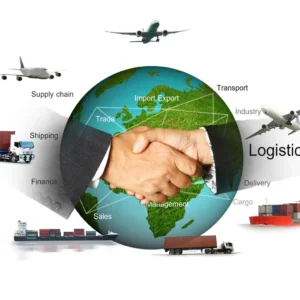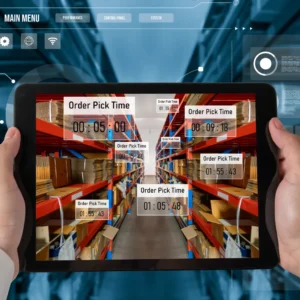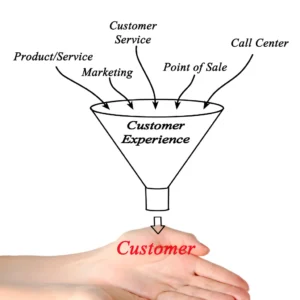
Navigating Efficiency
AI Tools for Predictive Analytics and Business Intelligence in Logistics Revolutionizing Decision-Making and Operations
In the dynamic logistics industry, cutting-edge technology integration has become imperative for streamlined operations and strategic foresight. The logistics industry’s AI Tools for Predictive Analytics and Business Intelligence are critical to revolutionizing decision-making processes.
Harnessing AI, these tools enable forecasting, pricing, analysis, and prediction. Every tool is specifically created to improve logistics efficiency and provide a competitive edge.
This discussion will delve into the essential components of these AI tools, exploring the requisite business knowledge, software and hardware requirements, integration nuances, and the training imperative for staff. Furthermore, we will analyze existing challenges, potential workarounds, and the cost and benefit dynamics associated with implementing these tools, guiding organizations to make informed choices in navigating the logistics landscape.
Table of Contents

Arindam Roy
An Automation Consultant with 25+ years of IT Experience
5 AI Tool ideas for Predictive Analytics and Business Intelligence
The Transportation and Logistics industry can benefit significantly from AI-powered tools, especially Predictive Analytics and Business Intelligence. Here’s an elaboration on the selected tools:
AI-Powered Demand Forecasting:
- Objective: Predict future demand for transportation and logistics services.
- How AI Can Help:
- Analyzing historical data so that we identify trends and patterns.
- Incorporating external factors like economic indicators, weather, and events.
- Continuous adaptation and learning to changing market conditions.
Predictive Pricing Analytics:
- Objective: Optimize pricing strategies for transportation and logistics services.
- How AI Can Help:
- Analyzing market demand, supply, and competitor pricing.
- Real-time adjustments are based on dynamic factors like fuel costs and regulatory changes.
- Optimization algorithms for finding the most competitive and profitable pricing.
Customer Behavior Analysis:
- Objective: Understand customer preferences, behaviour, and satisfaction.
- How AI Can Help:
- Analyzing customer data to identify preferences and patterns.
- Personalizing services and offerings based on individual customer behaviour.
- Performing sentiment analysis on social media and customer feedback can help organizations continuously improve their products, services, and overall customer experience.
Market Trends and Competitor Analysis:
- Objective: Stay ahead by understanding industry trends and competitor strategies.
- How AI Can Help:
- Web scraping and data mining for real-time information on market trends.
- Analyzing competitor activities, pricing strategies, and service offerings.
- Generating actionable insights to inform strategic decision-making.
Financial Performance Prediction:
- Objective: Predict and optimize financial performance for better decision-making.
- How AI Can Help:
- Analyzing financial data for cost optimization and revenue enhancement.
- Predicting potential financial risks and suggesting mitigations.
- Providing insights for investment decisions and resource allocation.
These AI tools can be integrated into a comprehensive platform that offers end-to-end analytics and business intelligence solutions for the Transportation and Logistics industry. The synergy of these tools can help companies enhance operational efficiency, improve customer satisfaction, and make informed decisions in a rapidly evolving market.
AI-Powered Demand Forecasting in Logistics
Business Knowledge Requirements:
- Logistics Domain Expertise:
- In-depth understanding of logistics operations, supply chain dynamics, and transportation demand factors.
- Familiarity with industry-specific challenges like seasonality, route optimization, and capacity constraints.
- Economic and External Factors:
- Knowledge of economic indicators affecting the transportation industry, such as GDP growth, inflation rates, and consumer spending patterns.
- Awareness of external factors like weather conditions, geopolitical events, and logistics regulatory changes.
- Data Governance:
- Understanding of data governance principles to ensure the quality, integrity, and reliability of historical and external data used in forecasting.
- Ensuring adherence to regulations about data privacy and maintaining ethical standards while handling sensitive data.
Software Requirements:
- Machine Learning Frameworks:
- Machine learning frameworks like TensorFlow, scikit-learn, or PyTorch are utilized to develop predictive models.
- Integration with advanced algorithms for time-series analysis and pattern recognition.
- Big Data Processing:
- Software for processing and managing large volumes of historical and real-time data.
- Implementation of distributed computing tools like Apache Spark for efficient data processing.
- Data Visualization Tools:
- Integration with data visualization tools (e.g., Tableau, Power BI) for presenting forecasted trends and insights to stakeholders.
- Customizable dashboards for real-time monitoring and analysis.
Hardware Requirements:
- Computational Resources:
- Adequate computing power for training and running machine learning models.
- Consideration of cloud-based solutions for scalability and flexibility based on demand fluctuations.
- Storage Capacity:
- Sufficient storage capacity for storing large datasets of historical and external data.
- Efficient data retrieval and storage solutions to ensure quick access during forecasting processes.
Integration Requirements to Existing Toolset:
- Enterprise Resource Planning (ERP) Integration: Integration with existing ERP systems to align demand forecasts with other business processes like inventory management and procurement.
- Transportation Management Systems (TMS) Integration: Seamless integration with TMS to incorporate real-time data on shipments, routes, and delivery schedules.
Training Required for Existing Staff:
- Data Scientists and Analysts:
- Training on machine learning algorithms and model development.
- Understanding of the logistics domain and factors influencing transportation demand.
- End Users:
- Training sessions for end-users on interpreting and utilizing forecasted data in decision-making processes.
- User-friendly interfaces to facilitate ease of use without extensive training.
Challenges and Workarounds in Implementing the Tool:
- Data Quality Challenges:
- Challenge: Only complete or accurate historical data.
- Workaround: Implement data cleansing and preprocessing techniques to enhance data quality.
- Model Accuracy:
- Challenge: Models may need to capture complex and dynamic demand patterns accurately.
- Workaround: Continuous model refinement and adaptation based on feedback and evolving market conditions.
Similar Tools Already Available in the Market:
- Blue Yonder (formerly JDA Software):
- Offers AI-powered demand forecasting solutions tailored for supply chain and logistics.
- Utilizes machine learning algorithms for enhanced accuracy.
- LLamasoft:
- Provides AI-driven supply chain analytics and demand forecasting solutions.
- Focuses on optimizing logistics and improving overall supply chain efficiency.
Cost and Benefit Analysis:
- Costs:
- Development Costs:
- Investment in developing and fine-tuning machine learning algorithms.
- Software development costs for creating a user-friendly interface.
- Integration Costs:
- Resources required for seamless integration with existing ERP and TMS systems.
- Potential customization costs based on specific business requirements.
- Development Costs:
- Benefits:
- Improved Forecast Accuracy: Early identification of demand trends and patterns leads to more accurate forecasts.
- Optimized Operations: Enhanced decision-making for inventory management, route planning, and resource allocation.
- Cost Reduction: Reduction in transportation costs through optimized route planning and inventory levels.
Recommendation: Integrate with Similar Available Products
Integrating with established AI-powered demand forecasting tools for Predictive Analytics and Business Intelligence, such as Blue Yonder or LLamasoft, is recommended.
Predictive Pricing Analytics in Logistics
Business Knowledge Requirements:
- Environmental Regulations and Standards:
- Deep understanding of environmental regulations and industry standards related to carbon emissions in the transportation sector.
- Knowledge of reporting requirements and compliance measures to ensure the tool aligns with global and regional sustainability goals.
- Transportation Operations Expertise:
- Expertise in logistics and transportation operations to accurately assess the carbon footprint of each shipment.
- Familiarity with different modes of transportation, fuel types, and their respective environmental impacts.
- Carbon Accounting Knowledge: Understanding of carbon accounting principles to ensure accurate tracking and calculation of carbon emissions throughout the supply chain.
Software Requirements:
- Carbon Footprint Calculation Algorithms:
- Development of algorithms to calculate the carbon footprint of shipments based on transportation mode, distance travelled, and fuel type.
- Integrating machine learning models to predict and optimize carbon emissions, considering factors like route optimization and alternative fuel options.
- Predictive Analytics Models: Implement predictive analytics models to forecast the potential carbon emissions of shipments under different scenarios, helping businesses make informed decisions.
- User Interface for Reporting: Creation of a user-friendly interface for stakeholders to access carbon footprint data, track sustainability metrics, and analyze the impact of various decisions on overall carbon emissions.
Hardware Requirements:
- Computing Power:
- Adequate computing power to handle the processing demands of machine learning models and complex algorithms.
- Consideration of cloud-based solutions for scalability and flexibility.
- Data Storage: Sufficient storage capacity for storing historical data and carbon footprint calculations, ensuring the system can handle large datasets over time.
Integration Requirements to Existing Toolset:
- Enterprise Resource Planning (ERP) Integration:
- Seamless integration with existing ERP systems to access relevant data, such as shipment details, fuel consumption, and operational parameters.
- Collaboration with other logistics tools to gather additional information on routes, transportation modes, and fuel types.
- Real-Time Data Integration: Integration with real-time data sources to provide up-to-date information on fuel prices, emission factors, and other dynamic variables affecting carbon footprint calculations.
Training Required for Existing Staff:
- Tool Usage Training: Training sessions to familiarize logistics and operational staff with the Carbon Footprint Tracking tool, including data input, interpretation of reports, and decision-making based on sustainability goals.
- Interpreting Sustainability Metrics: Education on interpreting carbon footprint data and understanding the implications of different decisions on overall sustainability metrics.
Challenges and Workarounds in Implementing the Tool:
- Data Accuracy and Availability:
- Challenge: Ensuring accurate and available data for carbon footprint calculations.
- Workaround: Establish data quality checks, collaborate with reliable data providers, and implement continuous monitoring for data accuracy.
- Algorithm Complexity:
- Challenge: Developing complex algorithms for accurate carbon footprint calculations.
- Workaround: Employ experienced data scientists, conduct thorough testing, and iterate on algorithms to improve accuracy over time.
- Stakeholder Adoption:
- Challenge: Encouraging stakeholders to use and trust the tool for decision-making actively.
- Workaround: Provide comprehensive training, showcase sustainability benefits, and regularly communicate the positive impact of informed decisions.
Similar Tools already available in the market:
- EcoChain: Offers a platform for tracking and optimizing carbon emissions throughout the supply chain, providing insights into sustainability metrics.
- TruCost: Provides carbon accounting solutions for businesses, helping them measure, manage, and report their carbon footprint.
Cost and Benefit Analysis:
- Costs:
- Development Costs: Investment in developing sophisticated algorithms, predictive analytics models, and a user-friendly interface.
- Integration Costs: Resources required for seamless integration with existing ERP systems and real-time data sources.
- Training Costs: Budget for training staff on using the Carbon Footprint Tracking tool and understanding sustainability metrics.
- Benefits:
- Sustainability Improvement: Facilitates informed decision-making, leading to reduced carbon emissions and overall improvement in sustainability practices.
- Regulatory Compliance: Minimizes the risk of operational penalties and disruptions by ensuring compliance with environmental regulations and standards.
- Brand Reputation Enhancement: By showcasing a dedication to environmental responsibility and sustainability, an organization can improve its brand reputation and image.
Recommendation: Integrate with Similar Available Products
Integrating with existing AI Tools for Sustainability and Green Logistics in the transportation and logistics industry, like EcoChain or TruCost, is recommended.
Customer Behaviour Analysis in Logistics
Business Knowledge Requirements:
- Logistics Industry Understanding:
- In-depth knowledge of logistics operations, including order fulfilment, delivery processes, and customer touchpoints.
- Awareness of specific challenges in the transportation industry, such as on-time delivery, inventory management, and supply chain visibility.
- Customer Journey Mapping:
- Understanding the customer journey within logistics, from order placement to delivery and post-service interactions.
- Knowledge of critical touchpoints where customer behaviour analysis can yield valuable insights.
- Data Privacy and Compliance:
- Awareness of data privacy regulations and compliance standards to ensure ethical and legal handling of customer data.
- Understanding the importance of secure data storage and transmission in compliance with industry-specific regulations.
Software Requirements:
- Customer Relationship Management (CRM) Software:
- Utilization of CRM software to centralize and manage customer interactions, transactions, and feedback.
- Integration with AI-powered analytics modules for customer behaviour analysis.
- Machine Learning and Predictive Analytics:
- Implementation of machine learning algorithms for predictive analysis of customer behaviour and preferences.
- Use of sentiment analysis tools to interpret customer feedback and social media sentiments.
- Data Visualization Tools:
- Integration with data visualization tools (e.g., Tableau, Power BI) for presenting customer behaviour insights comprehensibly.
- Customizable dashboards for real-time monitoring of customer satisfaction metrics.
Hardware Requirements:
- Computational Resources:
- Adequate computing power for running machine learning algorithms and analytics processes.
- Consideration of cloud-based solutions for scalability and flexibility.
- Storage Capacity:
- Sufficient storage capacity for storing and processing large volumes of customer data.
- Efficient data retrieval capabilities for quick access during analysis.
Integration Requirements to Existing Toolset:
- ERP Integration: Integration with ERP systems to align customer behaviour analysis with other business processes like inventory management and order processing.
- CRM Integration:
- Seamless integration with CRM systems for a unified view of customer interactions and preferences.
- Collaboration with customer support tools for a holistic understanding of customer satisfaction.
Training Required for Existing Staff:
- Customer Support Teams:
- Training on interpreting customer behaviour insights and leveraging them in improving customer interactions.
- Understanding the use of CRM and analytics tools for better customer engagement.
- Data Analysts:
- Training on utilizing machine learning and predictive analytics for customer behaviour analysis.
- Interpretation of sentiment analysis results and deriving actionable insights.
Challenges and Workarounds in Implementing the Tool:
- Data Integration Challenges:
- Challenge: Difficulty integrating data from various touchpoints into a unified customer profile.
- Workaround: Implement robust data integration processes and tools for a seamless flow of information.
- Sentiment Analysis Accuracy:
- Challenge: Ensuring accuracy in sentiment analysis, especially in interpreting nuanced customer feedback.
- Workaround: Continuously refine sentiment analysis algorithms and leverage human expertise for validation.
Similar Tools already available in the market:
- Salesforce CRM:
- Offers CRM solutions with AI-powered analytics for customer behaviour analysis.
- Provides tools for personalized customer engagement based on preferences and historical interactions.
- Zendesk:
- Provides customer support solutions with integrated analytics for understanding customer satisfaction.
- Offers sentiment analysis features for interpreting customer feedback.
Cost and Benefit Analysis:
- Costs:
- Software Development Costs:
- Investment in developing or customizing CRM software with AI-powered analytics capabilities.
- Integration costs with existing tools and systems.
- Training Costs:
- Budget for training staff on using the customer behaviour analysis tool and interpreting insights.
- Ongoing training to keep staff updated on evolving customer preferences.
- Software Development Costs:
- Benefits:
- Personalized Customer Engagement: Improved customer satisfaction through customized services based on individual behaviour analysis.
- Proactive Issue Resolution: Early identification of potential issues or dissatisfaction, allowing for proactive resolution.
- Brand Loyalty: Enhanced customer loyalty through tailored services and positive customer experiences.
Recommendation: Integrate with Similar Available Products
Integrating with established CRM solutions and other AI Tools for Predictive Analytics and Business Intelligence like Salesforce or Zendesk is recommended.
Market Trends and Competitor Analysis in Logistics
Business Knowledge Requirements:
- Transportation and Logistics Industry Expertise:
- In-depth understanding of the logistics landscape, including key players, regulatory frameworks, and market dynamics.
- Awareness of industry-specific challenges such as supply chain disruptions, capacity constraints, and technological advancements.
- Market Research and Analysis:
- Knowledge of market research methodologies to interpret trends and assess competitive landscapes.
- Understanding key performance indicators (KPIs) relevant to the logistics sector, such as market share, customer satisfaction, and pricing strategies.
- Strategic Decision-Making:
- Competence in strategic decision-making, incorporating insights from market trends and competitor analyses into business planning.
- Familiarity with long-term planning and risk assessment based on industry dynamics.
Software Requirements:
- Web Scraping and Data Mining Tools:
- Use web scraping tools to collect real-time data on market trends from various online sources.
- Data mining software to extract valuable insights from large datasets, including competitor activities and customer feedback.
- Data Analytics Platforms:
- Integration with data analytics platforms (e.g., Python with pandas, scikit-learn) for advanced data analysis and trend identification.
- Machine learning algorithms for predictive analytics to foresee potential industry shifts.
- Visualization Tools:
- Implement data visualization tools (e.g., Tableau, Power BI) for presenting trends and competitor analyses in a visually comprehensible format.
- Customizable dashboards for real-time monitoring and strategic planning.
Hardware Requirements:
- Computational Power:
- Adequate computing resources to support complex algorithms for data analysis and predictive analytics.
- Consideration of cloud-based solutions for scalability and flexibility.
- Storage Capacity:
- Sufficient storage capacity for storing large volumes of historical and real-time data.
- Efficient data retrieval capabilities for quick access during analyses.
Integration Requirements to Existing Toolset:
- ERP and CRM Integration:
- Align ERP and CRM systems for market and business process alignment.
- Customer data from CRM is utilized for a holistic view of market trends and customer preferences.
- Business Intelligence Integration:
- Seamless integration with existing Business Intelligence (BI) tools for comprehensive analytics and reporting.
- Correlation of market trend insights with internal performance metrics.
Training Required for Existing Staff:
- Data Analysts and Market Researchers:
- Training on web scraping and data mining tools for collecting relevant market data.
- Advanced training in data analytics and interpretation of trends for strategic decision-making.
- Decision-Makers and Executives:
- Training sessions on interpreting insights derived from the tool and incorporating them into strategic planning.
- Understanding the implications of market trends and competitor analyses on business objectives.
Challenges and Workarounds in Implementing the Tool:
- Data Quality Challenges:
- Challenge: Inconsistencies or inaccuracies in the data collected from various online sources.
- Workaround: Implement data validation processes and cross-reference information from multiple reliable sources.
- Dynamic Industry Landscape:
- Challenge: Rapid changes in the logistics industry make real-time analyses challenging.
- Workaround: Develop algorithms with adaptive learning capabilities to anticipate and respond to industry shifts.
Similar Tools already available in the market:
- CB Insights:
- Provides AI-powered market intelligence and competitor analysis tools for various industries, including logistics.
- Offers real-time insights, funding information, and competitive landscapes.
- Qlik Sense:
- A customizable business intelligence and data visualization tool for logistics industry analytics.
- Enables comprehensive data exploration and visualization for strategic decision-making.
Cost and Benefit Analysis:
- Costs:
- Software Development and Integration Costs:
- Investment in developing or customizing tools for web scraping, data mining, and analytics.
- Integration costs with existing systems and tools.
- Training Costs:
- Budget for training staff on using the market trends and competitor analysis tool and interpreting insights.
- Ongoing training to keep staff updated on evolving industry dynamics.
- Software Development and Integration Costs:
- Benefits:
- Strategic Decision Support: Informed decision-making based on real-time market trends and competitor strategies.
- Competitive Advantage: Staying ahead of competitors, proactively understanding and responding to industry shifts.
- Risk Mitigation: Anticipation of potential challenges and risks in the market, allowing for strategic risk mitigation.
Recommendation: Integrate with Similar Available Products
Integrating with established market intelligence tools like CB Insights or Qlik Sense is recommended.
Financial Performance Prediction in Logistics
Business Knowledge Requirements:
- Logistics Financial Understanding:
- In-depth knowledge of financial processes specific to the logistics industry, including cost structures, revenue streams, and financial metrics.
- Awareness of industry-specific financial challenges such as fuel price fluctuations, regulatory changes, and market competition impacts.
- Risk Management Expertise:
- Proficiency in risk management principles to understand potential financial risks and design effective mitigation strategies.
- Familiarity with industry-specific financial regulations and compliance requirements.
- Investment and Resource Allocation Knowledge:
- Understanding the factors influencing logistics investment decisions, including technology adoption, infrastructure development, and fleet expansion.
- Competence in resource allocation strategies to optimize financial performance.
Software Requirements:
- Financial Analytics Software:
- Utilization of financial analytics tools capable of processing large datasets to extract meaningful insights.
- Integration with machine learning algorithms for predictive financial modelling.
- Enterprise Resource Planning (ERP) System:
- Integration with ERP systems for seamless data flow between financial and operational modules.
- Utilization of financial data from ERP for comprehensive analysis.
- Machine Learning Frameworks:
- Implementation of machine learning frameworks such as TensorFlow or scikit-learn for predictive modelling.
- Algorithms for predicting financial outcomes, identifying cost-saving opportunities, and assessing revenue potential.
Hardware Requirements:
- Computational Power:
- Adequate computing resources to support complex algorithms for financial modelling and analysis.
- Consideration of cloud-based solutions for scalability and flexibility.
- Storage Capacity:
- Sufficient storage capacity for storing and processing large volumes of financial data.
- Efficient data retrieval capabilities for quick access during analyses.
Integration Requirements to Existing Toolset:
- ERP Integration:
- Seamless integration with existing ERP systems for accessing real-time financial and operational data.
- Correlation of financial performance predictions with operational metrics for holistic insights.
- Business Intelligence (BI) Integration:
- Integration with BI tools for creating dashboards and reports that visualize financial predictions.
- Collaboration with existing BI infrastructure for comprehensive analytics.
Training Required for Existing Staff:
- Financial Analysts:
- Training on using the financial performance prediction tool for data-driven decision-making.
- Interpretation of predictive analytics results for optimizing costs and enhancing revenue.
- System Administrators:
- Understanding system maintenance, monitoring, and data governance to ensure financial data integrity.
- Troubleshooting and handling potential issues in the financial analytics tool.
Challenges and Workarounds in Implementing the Tool:
- Data Quality Challenges:
- Challenge: Inaccurate or incomplete financial data affecting the accuracy of predictions.
- Workaround: Implement data validation processes and continuous monitoring to ensure data quality.
- Dynamic Industry Conditions:
- Challenge: Rapid changes in the logistics industry impact financial predictions.
- Workaround: Develop algorithms with adaptive learning capabilities to anticipate and respond to industry shifts.
Similar Tools already available in the market:
- IBM Planning Analytics:
- Provides AI-driven financial planning and analysis tools with predictive capabilities.
- Enables scenario modelling for assessing the impact of various factors on financial performance.
- Anaplan:
- Offers cloud-based financial planning and analytics solutions.
- Utilizes machine learning for predictive financial modelling and optimization.
Cost and Benefit Analysis:
- Costs:
- Software Development and Integration Costs:
- Investment in developing or customizing financial analytics tools with predictive capabilities.
- Integration costs with existing systems and tools.
- Training Costs:
- Budget for training financial analysts and system administrators on using the financial performance prediction tool and interpreting insights.
- Ongoing training to keep staff updated on evolving financial modelling techniques.
- Software Development and Integration Costs:
- Benefits:
- Cost Optimization: Identification of cost-saving opportunities through predictive financial analysis.
- Revenue Enhancement: Insights for optimizing revenue streams and identifying growth opportunities.
- Risk Mitigation: Early identification of potential financial risks and effective mitigation strategies.
Recommendation: Integrate with Similar Available Products
Integrating with established financial analytics tools like IBM Planning Analytics or Anaplan is recommended.
Conclusion on AI tools for Predictive Analytics and Business Intelligence in transportation and logistics
In conclusion, developing AI tools for predictive analytics and business intelligence in the logistics industry holds significant promise for enhancing operational efficiency and strategic decision-making. The identified tools, including AI-powered demand forecasting, predictive pricing analytics, customer behaviour analysis, market trends and competitor analysis, and financial performance prediction, collectively form a comprehensive suite tailored to the unique challenges of the transportation and logistics sector.
A comprehensive understanding of logistics operations, market dynamics, and financial intricacies is crucial for successfully implementing these tools. Integrating them with existing systems, such as ERP, CRM, and BI tools, is recommended for a seamless and holistic approach. Adequate staff training, encompassing data analysts, decision-makers, and system administrators, ensures optimal utilization and interpretation of AI-generated insights.
While data quality and dynamic industry conditions must be addressed, integrating with proven tools in the market, such as Darktrace for cybersecurity and established financial analytics platforms like IBM Planning Analytics, is recommended. This approach aligns with the organization’s identity as an IT/AI pioneer, offering quick deployment, industry expertise, cost-efficiency, scalability, and risk mitigation.
Adopting AI tools in the logistics industry is poised to drive proactive decision-making, optimize resource allocation, and navigate the evolving landscape, positioning the organization at the forefront of innovation within the transportation and logistics domain.
Related Articles
- AI Tools for Sustainability and Green Logistics
- AI Tools for Compliance and Regulatory Support
- AI Tools for Fleet Maintenance and Monitoring
- AI Tools for Operational Efficiency and Automation
- AI Tools for Supply Chain Visibility and Collaboration
- AI Tools for Order and Shipment Tracking
- AI Tools for Warehouse Management and Automation
- AI Tools for Route Optimization and Planning
- AI Tools for Risk Management and Security
- AI tools in the Transportation and Logistics industry

































